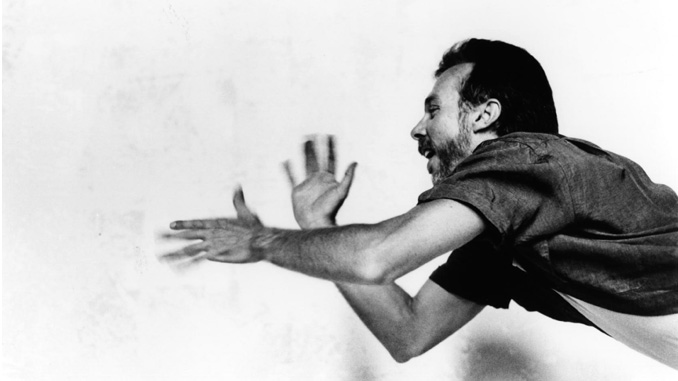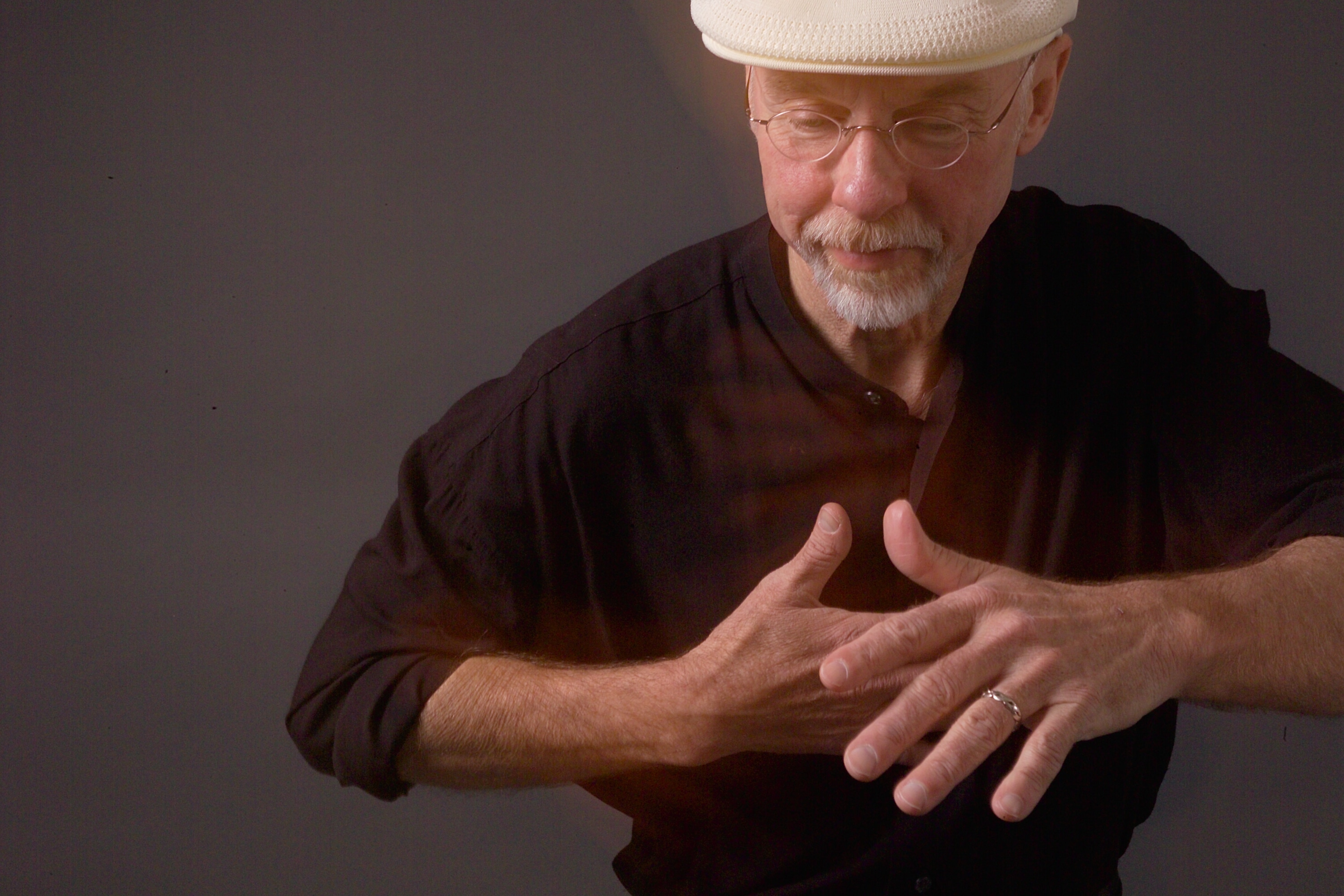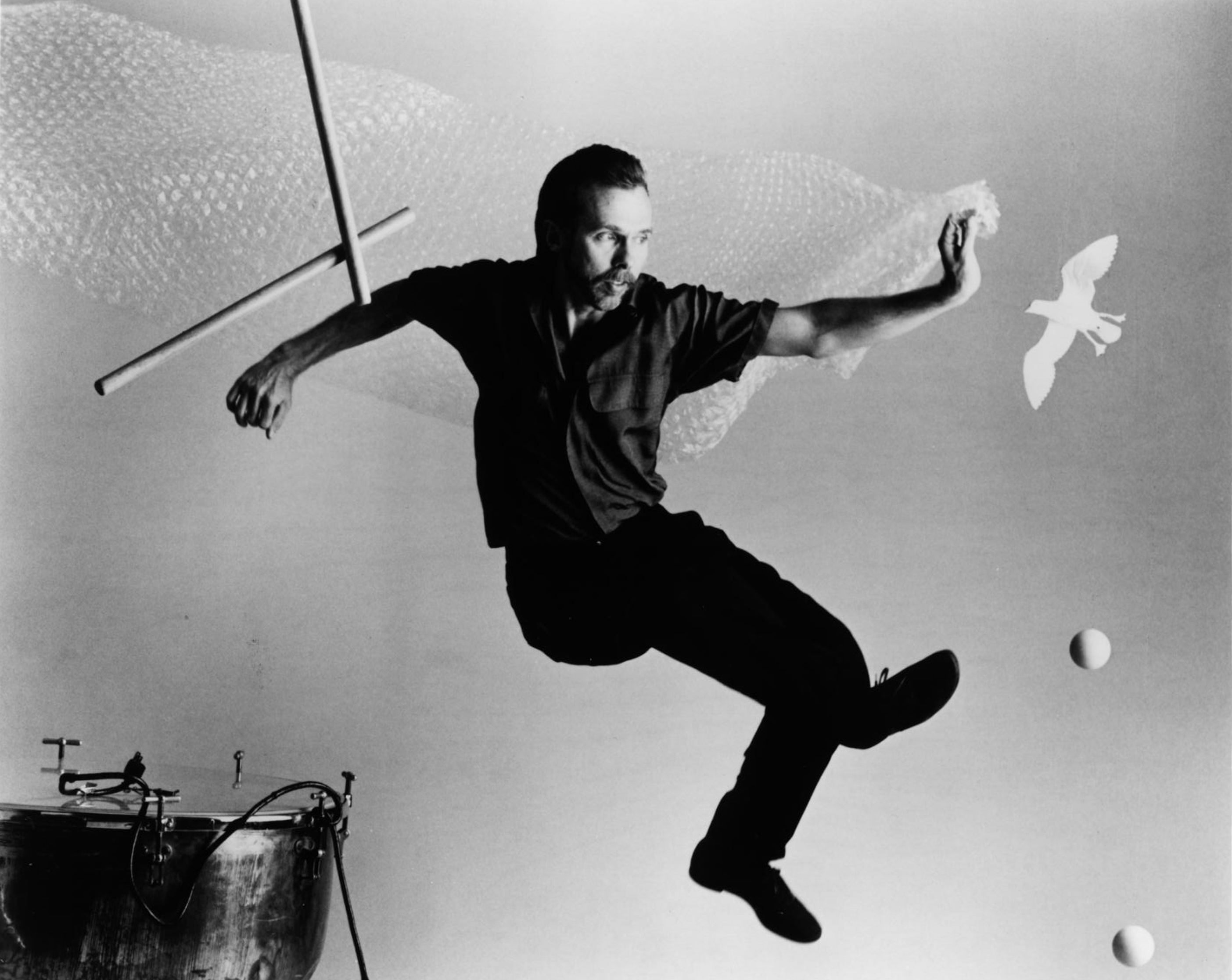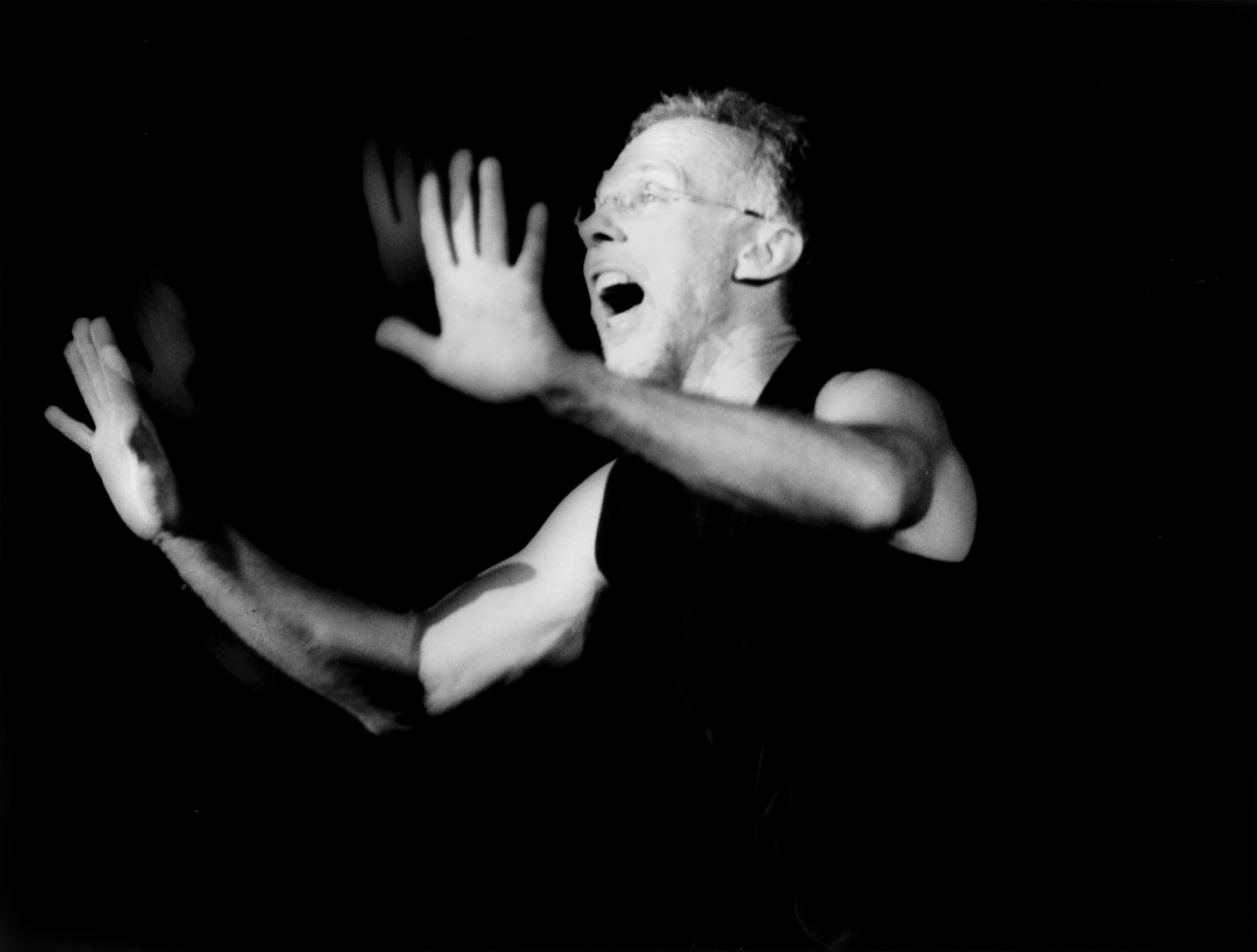
Body Music, also known as Body Percussion and Body Drumming, is the oldest music on the planet. Before people were hollowing logs and slapping rocks, they were using their bodies to stomp, clap, sing, snap and grunt their musical ideas.
There are many traditional Body Musics in the world, from African-American Hambone and Flamenco Palmas from Spain, to Sumatran Saman and Ethiopian Armpit music. Since 1978 Keith Terry has developed a contemporary style of Body Music based on his training as a jazz drummer, as well as his years of intensive study and collaboration with world rhythmic systems. (www.crosspulse.com)

Keith Terry is a percussionist/rhythm-dancer/educator whose artistic vision has straddled the line between music and dance for more than four decades. As a soloist he has appeared in such settings as Lincoln Center, Bumbershoot, NPR’s All Things Considered, PRI’s The World, the Vienna International Dance Festival, and the Paradiso van Slag World Drum Festival in Amsterdam. His groups – Slammin All-Body Band, Crosspulse Percussion Ensemble, Professor Terry’s Circus Band Extraordinaire, and Body Tjak (with I Wayan Dibia) – have performed in a variety of venues, including Joe’s Pub, WNYC, and Lincoln Center Out-of-Doors (NY); Grand Performances, LACMA Jazz, the Roxy, and the Skirball Center (LA); SFJazz, Vancouver Island MusicFest, and the Bali Arts Festival. In addition, Keith has performed with a wide range of artists including Charles “Honi” Coles, Turtle Island String Quartet, Jovino Santos Neto, Barbatuques, Gamelan Sekar Jaya, KeKeÇa, Kenny Endo, Freddie Hubbard, Tex Williams, Robin Williams, and Bobby McFerrin. As a producer he has released 6 CDs and 4 DVDs on Crosspulse Media.
Keith tours extensively in the Americas, Asia, and Europe, where his Body Music performances, workshops, residencies and choreographic commissions are popular among professional performers and educators. From 1998 to 2005 Keith was on the faculty at UCLA’s Department of World Arts and Culture s, where he designed and taught a dozen courses on the relationship of music and dance; deep listening; synchronicity, time, and timing; and intercultural communication in the arts. In 2006 he conceived and directed the first International Body Music Performance Project for the Orff Institute in Salzburg, Austria. In 2010 Keith was on the Dance Program faculty at UC Berkeley.
s, where he designed and taught a dozen courses on the relationship of music and dance; deep listening; synchronicity, time, and timing; and intercultural communication in the arts. In 2006 he conceived and directed the first International Body Music Performance Project for the Orff Institute in Salzburg, Austria. In 2010 Keith was on the Dance Program faculty at UC Berkeley.
Keith Terry is the founding Artistic Director of the International Body Music Festival (IBMF). Launched in 2008, this annual, six day festival explores the language of body music from culture to culture and has been produced in the US, Brazil and Turkey. In 2010 Keith directed and performed in IBMF’s “Americas” concert for the Lincoln Center Out of Doors Festival in New York. Keith is a 2008 Guggenheim Fellow, as well as the Founding Director of Crosspulse, a 36 year-old, Oakland, CA –based, non-profit organization dedicated to the creation and performance of rhythm-based intercultural music and dance.
Video clips:
 Keith Terry solo performance: http://www.youtube.com/watch?v=3Ysq0rh5ZaQ
Keith Terry solo performance: http://www.youtube.com/watch?v=3Ysq0rh5ZaQ
Keith Terry on Public Radio International’s THE WORLD:
http://www.youtube.com/watch?v=gKzko9z8jU8
Keith Terry’s Body Music Improv with Slammin’ All-Body Band:
http://www.youtube.com/watch?v=TCltR3kAYI0
Keith Terry on NPR’s Here and Now: http://hereandnow.wbur.org/2013/11/18/keith-terry-music
6th International Body Music Festival promo video: http://youtu.be/bl7F9gY7bKE
Keith Terry’s BODY TJAK: http://www.youtube.com/watch?v=kNOSo85kNTM&feature=related
Keith Terry in Detroit Schools and his Quartet in Ann Arbor: http://www.youtube.com/watch?v=ZFxLh51_odk&feature=related
Keith Terry’s Crosspulse Percussion Ensembles for Kids and their Families: http://www.youtube.com/watch?v=R1p64cBD9f8
INTERVIEW
1. When did you start feeling interested to Body Music?
In 1978 I started experimenting with transferring the patterns I was playing on my drum set on to my body. It was then that I began making pieces for the Jazz Tap Ensemble, a sextet I was working with at the time. I also started «playing the audience» during this period – interacting with large crowds of people – clapping, snapping, stepping, and vocalizing in live, improvisational settings.
2. How would you define Body Music?
Body Music is that music created by clapping, slapping, snapping, stepping and vocalizing. It’s very old, likely the first music, before we were hollowing logs, slapping rocks, and using gourds to create «external» instruments. I started coining the term «Body Music» in 1978 at the suggestion of my friend/colleague Paul Arslanian. I like the term, as opposed to Body Percussion or Body Drumming, because for me it implies melody and harmony with the use of the voice – not just the rhythmic possibilities.
3. In which ways we can work with Body Music?
It’s a performance outlet, obviously, but also a great educational tool for musicians, dancers, actors, deejays, film editors — anyone involved in manipulating rhythm and time. It helps to improve rhythmic sensibility, time and timing, and ensemble awareness. It’s also sometimes useful for working with children, seniors, those who are deaf, those with down syndrome or memory loss, and others with special physical, psychological, or emotional needs.
4. Where can we find more information about your work?
www.crosspulse.com and www.internationalbodymusicfestival.com
THANK YOU!
—————————
TRADUCCIÓN
Body Music con Keith Terry
El Body Music, también conocido como Body Percussion y Body Drumming, es la música más antigua del planeta. Antes de que las personas ahuecaran los troncos y golpearan las piedras, utilizaban sus cuerpos para dar pisotones, aplaudir, cantar, dar chasquidos y gruñir sus ideas musicales. En el mundo hay muchas músicas de Body Music tradicionales, desde el Hambone Afroamericano y las palmas en el Flamenco de España, hasta el Saman de Sumatra y la música etíope de axila. Desde 1978 Keith Terry ha desarrollado un estilo contemporáneo de Body Music basado en su formación como baterista de jazz, así como en sus años de estudio intensivo y la colaboración con los sistemas rítmicos del mundo. (www.crosspulse.com)
Keith Terry es un percusionista/bailarín-rítmico/educador cuya visión artística ha abarcado la línea entre la música y la danza desde hace más de cuatro décadas. Como solista ha actuado en escenarios como el Lincoln Center, Bumbershoot, NPR’s All Things Considered, PRI’s The World, el Vienna International Dance Festival, y el Paradiso van Slag World Drum Festival de Amsterdam. Sus grupos – Slammin All-Body Band, Crosspulse Percussion Ensemble, Professor Terry’s Circus Band Extraordinaire, y Body Tjak (with I Wayan Dibia) – se han presentado en una variedad de lugares, incluyendo Joe’s Pub, WNYC, y Lincoln Center Out-of-Doors (NY); Grand Performances, LACMA Jazz, the Roxy, y el Skirball Center (LA); SFJazz, Vancouver Island MusicFest, y el Bali Arts Festival. Además, Keith ha actuado con una amplia gama de artistas como Charles “Honi” Coles, Turtle Island String Quartet, Jovino Santos Neto, Barbatuques, Gamelan Sekar Jaya, KeKeÇa, Kenny Endo, Freddie Hubbard, Tex Williams, Robin Williams, and Bobby McFerrin. Como productor ha editado 6 CDs y 4 DVDs en Crosspulse Media.
Keith realiza extensas giras en América, Asia y Europa, donde sus actuaciones de Body Music, talleres, residencias y comisiones coreográficas son populares entre los artistas profesionales y educadores. De 1998 a 2005 Keith estuvo en la facultad del Departamento de Artes del Mundo y Culturas, donde diseñó y enseñó una docena de cursos sobre la relación entre la música y la danza de la UCLA; escucha profunda; sincronicidad, el tempo, y el pulso; y la comunicación intercultural en las artes. En 2006 concibió y dirigió el primer proyecto International Body Music Performance Project para el Instituto Orff en Salzburgo, Austria. En 2010 Keith estuvo en el Programa de Danza de la facultad de la UC Berkeley.
Keith Terry es el Director Artístico fundador del International Body Music Festival (IBMF). Lanzado en 2008, este festival anual de seis días explora el lenguaje del Body Music de cultura a cultura y se ha producido en los EE.UU., Brasil y Turquía. En 2010 Keith dirigió y actuó en el concierto IBMF’s “Americas” para el Lincoln Center Out of Doors Festival en Nueva York. Keith es miembro del Guggenheim 2008, así como el Director Fundador de Crosspulse, una organización de 36 años, con base en Oakland, CA, sin ánimo de lucro, y dedicada a la creación y desempeño de la música y la danza intercultural basada en el ritmo.
ENTREVISTA
1. ¿Cuándo comenzaste a sentirte interesado por el Body Music?
En 1978 comencé a experimentar transfiriendo sobre mi cuerpo los patrones que tocaba en la batería. Fue entonces cuando comencé a crear piezas para el Jazz Tap Ensemble, un sexteto con el que estaba trabajando en ese momento. También empecé a «tocar la audiencia» durante ese tiempo – interaccionando con gran multitudes de personas – dando palmas, chasquidos, pasos, y vocalizando en directo, en escenarios de improvisación.
2. ¿Cómo definirías Body Music?
Body Music es esa música creada con palmas, percusión, chasquidos, pasos y vocalizando. Es muy antiguo, probablemente la primera música, antes de que ahuecáramos los troncos, percutiéramos las piedras, y utilizáramos calabazas para crear instrumentos «externos». Comencé a acuñar el término «Body Music» en 1978 por sugerencia de mi amigo/colega Paul Arslanian. Me gustó el término, a diferencia de Body Percussion o Body Drumming, porque para mí implica melodía y armonía con el uso de la voz – no sólo las posibilidades rítmicas.
3. ¿De qué formas podemos trabajar con Body Music?
Es un forma de desempeñarse, obviamente, pero también una gran herramienta educativa para los músicos, bailarines, actores, deejays, editores de cine – cualquier persona involucrada en la manipulación de ritmo y tiempo. Ayuda a mejorar la sensibilidad rítmica, el tempo y el pulso, y la conciencia de conjunto. A veces también es útil para trabajar con niños, personas mayores, aquellos que son sordos, personas con síndrome de down o pérdida de la memoria, y otros físicamente/psicológicamente especiales, o con necesidades emocionales.
4. ¿Dónde podemos encontrar más información sobre tu trabajo? www.crosspulse.com y www.internationalbodymusicfestival.com
¡MUCHAS GRACIAS!

Dejar una contestacion